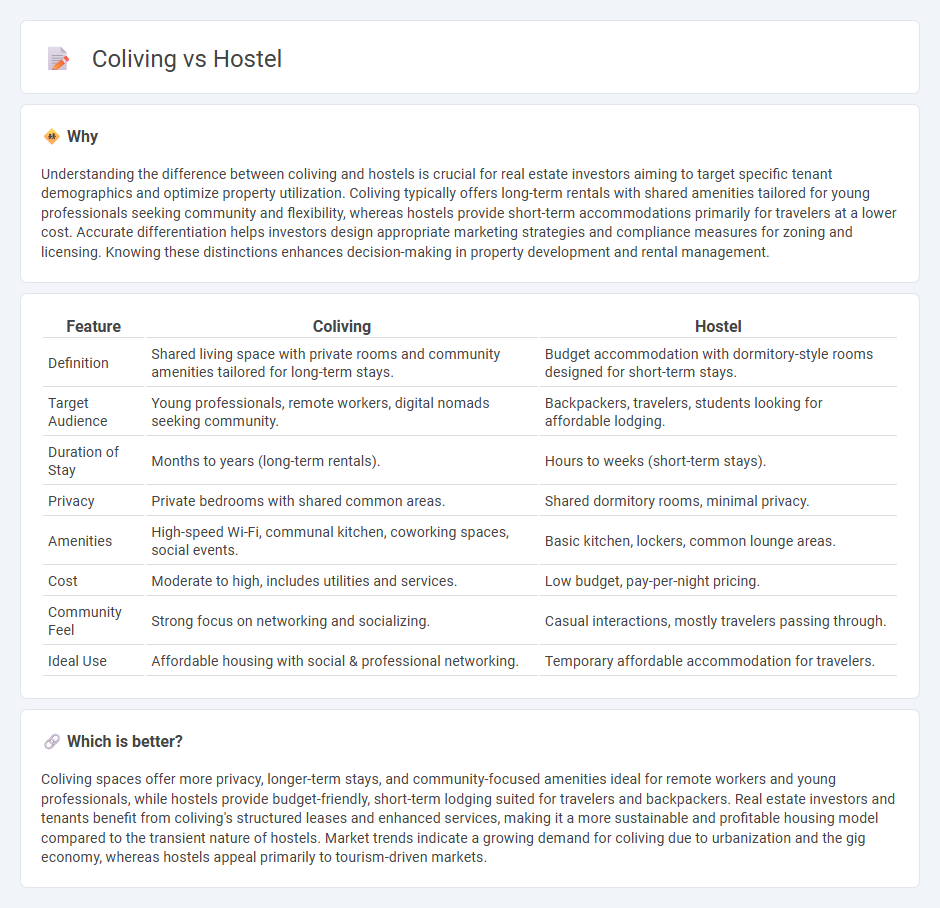
Coliving spaces offer shared living environments designed for long-term stays with amenities that foster community and collaboration, popular among remote workers and digital nomads. Hostels provide budget-friendly, short-term accommodation primarily targeting travelers seeking social interaction and flexible lodging options. Explore the key differences and benefits of coliving versus hostels to find the ideal living arrangement for your lifestyle.
Why it is important
Understanding the difference between coliving and hostels is crucial for real estate investors aiming to target specific tenant demographics and optimize property utilization. Coliving typically offers long-term rentals with shared amenities tailored for young professionals seeking community and flexibility, whereas hostels provide short-term accommodations primarily for travelers at a lower cost. Accurate differentiation helps investors design appropriate marketing strategies and compliance measures for zoning and licensing. Knowing these distinctions enhances decision-making in property development and rental management.
Comparison Table
| Feature | Coliving | Hostel |
|---|---|---|
| Definition | Shared living space with private rooms and community amenities tailored for long-term stays. | Budget accommodation with dormitory-style rooms designed for short-term stays. |
| Target Audience | Young professionals, remote workers, digital nomads seeking community. | Backpackers, travelers, students looking for affordable lodging. |
| Duration of Stay | Months to years (long-term rentals). | Hours to weeks (short-term stays). |
| Privacy | Private bedrooms with shared common areas. | Shared dormitory rooms, minimal privacy. |
| Amenities | High-speed Wi-Fi, communal kitchen, coworking spaces, social events. | Basic kitchen, lockers, common lounge areas. |
| Cost | Moderate to high, includes utilities and services. | Low budget, pay-per-night pricing. |
| Community Feel | Strong focus on networking and socializing. | Casual interactions, mostly travelers passing through. |
| Ideal Use | Affordable housing with social & professional networking. | Temporary affordable accommodation for travelers. |
Which is better?
Coliving spaces offer more privacy, longer-term stays, and community-focused amenities ideal for remote workers and young professionals, while hostels provide budget-friendly, short-term lodging suited for travelers and backpackers. Real estate investors and tenants benefit from coliving's structured leases and enhanced services, making it a more sustainable and profitable housing model compared to the transient nature of hostels. Market trends indicate a growing demand for coliving due to urbanization and the gig economy, whereas hostels appeal primarily to tourism-driven markets.
Connection
Coliving and hostels share a focus on affordable, community-driven housing solutions that cater to millennials, digital nomads, and young professionals seeking flexible living arrangements. Both models emphasize shared common areas, such as kitchens and lounges, promoting social interaction and networking opportunities within urban real estate markets. The rise of coliving spaces and hostels reflects changing housing preferences driven by urbanization, remote work trends, and the demand for cost-effective, short-to-medium term accommodations.
Key Terms
Occupancy Type
Hostels primarily cater to short-term travelers, offering dormitory-style rooms designed for single-night or brief stays, maximizing occupancy through shared facilities. Coliving spaces target long-term residents, providing private bedrooms within shared apartments or houses, fostering community while maintaining personal privacy. Explore more about how occupancy types shape the hostel and coliving experiences.
Lease Agreement
Lease agreements for hostels often involve short-term, flexible stays with minimal commitments, catering to travelers seeking affordable accommodation. In contrast, coliving arrangements typically require longer lease durations with more structured contracts that include shared amenities and community rules. Explore the key differences in lease agreements to choose the best living option for your needs.
Amenities
Hostels typically offer basic amenities such as shared dormitories, communal kitchens, free Wi-Fi, and common lounge areas designed for budget travelers and backpackers seeking social experiences. Coliving spaces focus on enhanced amenities including private bedrooms, coworking spaces, community events, fitness centers, and curated social programs aimed at remote workers and urban professionals. Discover how these distinct amenities shape your living experience by exploring detailed comparisons and options.
Source and External Links
Hostel - Wikipedia - A hostel is a low-cost, short-term shared lodging option where guests rent beds (often bunk beds) in dormitory rooms with shared facilities, popular among backpackers and youth travelers for its affordability and social environment.
Hostel (2005 film) - Wikipedia - Hostel is a 2005 horror film directed by Eli Roth, following American tourists who fall victim to a torture and murder scheme in Slovakia, spawning a successful film series.
Hostels Worldwide - Online Bookings, Ratings and Reviews - Hostelworld provides online bookings, traveler profiles, chat features, and travel guides for hostels globally, helping backpackers connect and plan sociable, budget accommodations.
 dowidth.com
dowidth.com